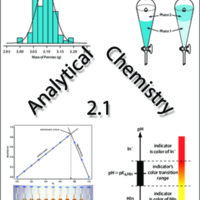Analytical Chemistry 2.1
Dublin Core
Title
Subject
Description
Chemistry is the study of matter, including its composition, its structure, its physical properties,
and its reactivity. Although there are many ways to study chemistry, traditionally we divide it into ve areas: organic chemistry, inorganic chemistry, biochemistry, physical chemistry, and analytical chemistry. is division is historical and, perhaps, arbitrary, as suggested by current interest in interdisciplinary areas, such as bioanalytical chemistry and organometallic chemistry. Nevertheless, these ve areas remain the simplest division that spans the discipline of chemistry. Each of these traditional areas of chemistry brings a unique perspective to how a chemist makes sense of the diverse array of elements, ions, and molecules (both small and large) that
make up our physical environment. An undergraduate chemistry course, therefore, is much more than a collection of facts; it is
and its reactivity. Although there are many ways to study chemistry, traditionally we divide it into ve areas: organic chemistry, inorganic chemistry, biochemistry, physical chemistry, and analytical chemistry. is division is historical and, perhaps, arbitrary, as suggested by current interest in interdisciplinary areas, such as bioanalytical chemistry and organometallic chemistry. Nevertheless, these ve areas remain the simplest division that spans the discipline of chemistry. Each of these traditional areas of chemistry brings a unique perspective to how a chemist makes sense of the diverse array of elements, ions, and molecules (both small and large) that
make up our physical environment. An undergraduate chemistry course, therefore, is much more than a collection of facts; it is
Creator
Source
https://open.umn.edu/opentextbooks/textbooks
Publisher
Date
2016
Contributor
Baihaqi
Rights
Creative Commons
Format
PDF
Language
English
Type
Files
Collection
Citation
David Harvey, , “Analytical Chemistry 2.1,” Open Educational Resources (OER) , accessed August 23, 2025, https://oer.uinsyahada.ac.id/items/show/2415.


